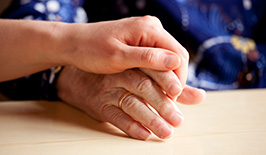Interview about our services from Comfort Keepers

Avow Hospice
Avow was founded in 1983 as Collier County’s original, nonprofit hospice. Today, Avow’s nonprofit companies provide palliative care consultations for adults facing chronic or serious illness, hospice care and bereavement support services for children and adults
Avow delivers a better quality of life by providing comfort, care, understanding and dignity to those who are seriously ill and their caregivers, as well as those mourning a loved one’s passing. We are a support system in our community, providing our services to anyone who needs them, including those whose loved ones were not in our programs. We also support those who are suffering the illness or loss of a companion animal.
Avow’s promise is to help members of our community provide care at home and live at home during an illness or death, surrounded by the people, pets and things they love most. We are teachers and guides, offering our expertise and loving support but always respecting the beliefs, choices and wishes of those we serve.
We often make positive, life-altering changes in someone’s life in as little as a moment. Therefore, even if our time with a patient, family member or community resident is brief, we bring it our full attention and focus on resolution and healing.
Help for Those in Grief
Whether you’ve lost someone who utilized our hospice care or not, Avow welcomes the grieving with open arms.
The following grief support services are available to anyone in the community…
- Grief and bereavement support through individual or group meetings and regular follow-up.
- Support for children who will or have experienced the loss of a parent or other loved one.
- Help planning a private memorial service, if desired.
-
Community memorial programs including Butterfly Releases and Avow RememberingSM memorial services. Invite family and friends. Click Here To Learn More (Check our calendar for the date of our next offering or call us.).
- Public emergency response services. Click Here To Learn More
- Pet Loss Support, for those who have suffered the death of a companion animal.
Support for the mind, body and spirit
Dealing with the symptoms of any painful or serious illness is difficult. Palliative care can help. Palliative care can be offered at the same time you’re receiving treatments for your illness. Its primary purpose is to relieve the pain and other symptoms you are experiencing and improve your quality of life.
Live your life more comfortably
Palliative care provides relief from distressing symptoms including pain, shortness of breath, fatigue, constipation, nausea, loss of appetite, problems with sleep and many other symptoms. It can also help you deal with the side effects of the medical treatments you receive. Most important, palliative care can help improve the quality of your life.
Palliative care also provides support for you and your family and can improve communication between you and your health care providers.
It’s never too early to learn about the benefits of hospice care. It’s not just for people in the last days of their lives. The reality is that, in many cases, hospice care can actually help people live longer. In virtually every case, hospice care brings significant comfort, peace and dignity to patients who are fearful, vulnerable, confused or exhausted from curative medical treatments that have failed to stop the progress of their illness.
Hospice cares is for people who are terminally ill and have an estimated lifespan of six months or less. Hospice is for anyone, of any age, who has a life-limited illness.
Each hospice patient and family has a team working together that supplements, but does not replace, the care provided by families, staff at an adult living facility, and other full-time caregivers.
Caregiver Support Programs
Caring for someone with a serious illness can be very rewarding, but it can also be difficult and overwhelming. Avow is here to ease your mind and help you cope. We offer a variety of services including support groups, volunteer support and help finding resources in the community that can help you.
Avow’s caregiver support groups are open to anyone in the community; neither the caregiver nor the patient needs to be associated with Avow’s hospice services in any way. Attendees may be parents, spouses, children or friends of people suffering from cancer, dementia, heart disease, Parkinson’s disease, stroke, frailty or any other condition. Attendees can participate at whatever level they feel comfortable. Group leaders also help caregivers find resources in the community for whatever types of assistance their loved ones may need. See the link at the bottom of the page to view monthly support group schedules.
For more information, go to www.seniorhousingsolutions.net

How do you pay for Assisted Living?
As senior housing advisors, we speak with many clients who need assisted living and not sure how to pay for it. There are some resources that you may be unaware.
Medicare?
Medicare will only pay for care in Medicare-certified skilled nursing facility or through Medicare-certified home health or hospice agencies. It will never pay for care in an assisted living facility.
Medicaid?
The Medicaid Waiver Program is available throughout the state of Florida, however interested applicants should be aware that unlike other Medicaid programs, this is not an entitlement. One may meet all the eligibility requirements only to find that there are no available rooms and they are put on a waiting list for services. It is important to note that not all assisted living facilities accept the Medicaid Waiver Program and it might be necessary to move out of the area to find a facility that accepts it. Typically, the Medicaid Waiver Program only pays for a portion of your rent and does not pay for care-related charges. One should contact their local Area Agency on Aging to learn more and determine if a wait list exists in their geographic area.
Other state programs?
One program is called PACE (Program of All-Inclusive Care for the Elderly).
If you qualify, PACE will cover all the medical, social and rehabilitative services you need, including items that Medicare does not cover, such as social work services, meals and nursing home care. You will receive all your health care (Medicare and Medicaid benefits) through the PACE program.
There are eligibility requirements of the PACE program as well as stipulations that you must agree to qualify. Like the Medicaid Waiver program, only a limited number of assisted living facilities in our area accepts PACE. In addition, PACE is a state funded program with limited resources, therefore there are times when PACE stops accepting new candidates. For more information, contact the Florida Department of Elder Affairs.
Veteran’s Administration (VA)?
The Aid and Attendance Benefit offered through the Veteran’s Administration is not a well-known benefit, yet it could be one of the most important benefits you could receive. This program was established for eligible Veterans and their Spouses to help pay for assisted living, skilled nursing and home health care. The Veteran or Spouse qualifies for this benefit if their service, medical qualifications and financial criteria are met.
To medically qualify, you would need assistance with two or more “activities of daily living’ (ADLs). These would include:
- Medication management
- Bathing or hygienic tasks
- Meal management
- Transferring
- Mobility
- Dressing
- Continence
The Veteran must have service one day of active duty during a wartime period and was honorably discharged. Spouses who have been divorced are not eligible.
Based on your income, the Aid and Attendance program could pay:
2017 Maximum Monthly Benefits:
Veteran with Spouse: $2,127
Single Veteran: $1,794
Surviving Spouse: $1,153
Dependent Spouse: $1,408
This program pays the Veteran or Spouse and not the assisted living facility, therefore it is applicable at all assisted living facilities.
For more information, contact the Veteran’s Administration.
Long term care insurance?
If you have a long-term care insurance policy, you should review your policy to determine what it covers and what it doesn’t. Every policy is different. Many policies have an elimination period, typically 90 days and have specific guidelines about which type of facility they will reimburse.
Usually, the long-term care insurance carrier pays you the benefit; therefore, providing the assisted living facility meets the criteria for reimbursement, you would be paid the benefit amount, not the facility.
Private pay?
The most common way to pay for assisted living is out of pocket. People use their own investments or the proceeds of the sale of their residence. Family members also contribute. It is wise to speak to your financial advisor BEFORE you need assisted living and develop a plan for your future health care needs. These might include annuities, trusts, reverse mortgages and other investment strategies.
Meals, housekeeping, home maintenance, transportation, social activities, utilities, cable, taxes and care are typically included in your rent, therefore your overhead expenses are many times less than what you are paying at home.
We are here to help.
Senior Housing Solutions is familiar with all the assisted living facilities in our area and can help find a ‘solution’ for you. Our services are 100% free! We are not financial advisors, therefore cannot provide financial advice. We recommend resources to help you every step of the way. For more information, please call (239)595-0207 or visit our website at: www.seniorhousingsolutions.net.

The Role of a Senior Housing Advisor
The Role of a Senior Housing Advisor
Do you handle your legal affairs without consulting with your attorney? Do you file your own tax returns without consulting with your CPA? Do you handle your financial matters without speaking with your financial advisor? Seeking the advice of an expert is a wise decision. An expert has years of experience in the specific area you are considering and has much more knowledge and resources available to give you the best possible advice.
Selecting and moving to a senior community is a life-changing decision. It involves a financial commitment, lifestyle choice, downsizing adjustment and many emotions. The last thing you would want to do is move somewhere and not be happy or find out the senior community has some financial or operational issues. Yes, you can try it do it on your own, however wouldn’t it be better to seek the advice of someone who truly knows the ins and outs of all the places you are considering?
Be wary of senior housing internet search providers. These companies aggressively advertise on the internet. What you don’t know is that once you call them or fill out their online form, they basically “own you” and will sell your contact information to third parties. You will be bombarded with phone calls and emails. The worst part is that these internet search providers know very little about the senior communities they are recommending. They seldom visit these places and are not current on any issues the senior community could be experiencing. They provide you with a list of places that they have under their contract, which may or may not fit you needs. It is much better to work with a Senior Housing Advisor who is knowledgeable about the local market and all the senior living options.
We know what you don’t know!
As a trusted senior housing advisor, our role is to provide you with the possible advice. We are familiar with all the places in the area and keep current on pricing, availability, significant operational and staffing issues as well as future trends in the market place. We do our best to match your needs and preferences to the best options available. We know that some folks are ready to make the move, but want the peace of mind of knowing they have reached ahead for their future options.
Senior Housing Solutions is locally owned and operated and has over 30 years’ experience in the senior housing industry. Our personalized approach allows us to get to know you and help you every step of the way. Our proven 5 Step process provides you with a comprehensive and objective information to help you with your decision. Best of all, our services are 100% FREE! It’s what we do!
- Step 1: We meet with you to get to know you, most of the times, this is done in the comfort of your own home. We discuss your needs and preferences and provide you with a list of assisted living options best fits your needs.
- Step 2: We schedule visits with communities of your choice and join you during these community visits to help represent you. We ask questions on topics you may not know to ask and follow up with you to discuss pros/cons of each of your options.
- Step 3: We review pricing, level of service plans and residency agreements to make sure you fully understand the fine print at these communities. We review State of Florida Health Care survey reports and negotiate pricing, as appropriate.
- Step 4: We provide you with comprehensive and trusted resources to assist you with the move transition and provide you with recommendations of key professionals, as necessary. We also provide you with resources to assist you with your Veteran’s Benefits.
- Step 5: After you move in, we will follow up with you to make sure you are happy with your decision. We will discuss any issues with community staff for resolution and communicate with your family, as appropriate.
We are in your corner, every step of the way!
We hear reviews from many of our clients who tells us that could not have done it without our help. Personally, I am not sure how anyone can make this type of decision with our expert advice and why would you want to? Our services are free so why wouldn’t you utilize them? We look forward to speaking with you.
